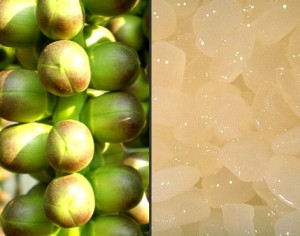 Sugar palm or kaong (Arenga pinnata) is considered as a minor forest species that provides two important food products: the sweet preserved sugar palm or kaong and vinegar which are great potentials for export. In the Philippines, preserved sugar palm or kaong is a very popular ingredient for Halo-halo, salad and can be eaten alone as dessert.
Sugar palm or kaong (Arenga pinnata) is considered as a minor forest species that provides two important food products: the sweet preserved sugar palm or kaong and vinegar which are great potentials for export. In the Philippines, preserved sugar palm or kaong is a very popular ingredient for Halo-halo, salad and can be eaten alone as dessert.
Making preserved sugar palm or kaong is easy and the materials are findable in the market. It is a good profitable business to start in your own home.
Materials:
- 360 kg. White sugar
- 200 g. Sodium metabisulfide
- 2,880 pcs. Bottles
- 2,880 pcs. Plastic sealer
- 100 bundles Fuelwood
- 2 pcs. Ladle
- 10 pcs. (5 gallon capacity) Oil can
- Wok
- 2 pcs. Strainers
- 1,200 bunches Kaong nuts
Procedure:
A. Harvesting
- Select the bunch having mature fruits. A bunch may contain 4,000-5,000 fruits.
- Cut selected bunch using a sharp bolo (30-50 cm) from the main trunk.
- Bundle the bunch of the fruits for easy handling and transporting.
- Detach individual fruit using a knife. Do not touch the sap as it causes skin irritation.
B. Extraction
- Place the fruits in the container and add water just within the level of the fruits.
- Boil for two to three hours.
- Cut the tips of the fruit at 1 cm crosswise from the apical portion.
- Prick the meat in the upper portion of the fruit using a knife.
- Wash the meat with clean water, two to three times to eliminate unnecessary materials.
- Soak the meat in water overnight to maintain the freshness.
- Strain the meat in the plastic mesh/strainer.
- Unsweetened kaong is ready for market.
Caution: Kaong fruits are toxic for dogs.
C. Processing into Kaong Preserves
- Prepare syrup by boiling two cups white sugar, one cup water, and 0.1% sodium metabisulfide.
- Add three cups of kaong to the boiling syrup.
- Cook for 10 minutes and cool.
- Place kaong in a sterilized bottle and seal.
- After sealing, boil for another 10 minutes to eliminate the air bubbles.
- Label before marketing.
Note: The producer may opt to sell kaong preserves in bottles of varied size.
Source: DTI-PTTC, stii.dost.gov.ph